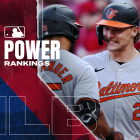For the second winter in a row, free agency is taking an uncommonly, excruciatingly long time to develop. Gone are the days when December's winter meetings actually produced major headlines and major signings. Instead, players are waiting until the new year to sign. In many cases, they're waiting until the eve of spring training, or even after spring training has begun, to sign on the dotted line.
We recently explored some of the biggest reasons behind teams' sudden distaste for paying power hitters. But more than that, teams are gaining the upper hand in negotiations, citing fiscal responsibility in holding the line on contracts, in many cases forcing players to settle for one-year deals.
When those one-year deals expire, those players all go back on the open market, further cluttering the landscape with talent and giving teams even more leverage to wait on, say, a relief pitcher or second baseman. When a dozen teams jump into some kind of rebuild all at the same time, the list of motivated buyers shrinks even further, throwing even more leverage teams' way.
What do the people who run front offices have to say about some of the market's shifting trends? We polled a number of different executives to find some additional answers. To do so, we asked three simple questions:
- Why is it taking so long for Manny Machado and Bryce Harper to sign?
- Does the slower-to-develop market for free agents annoy teams as you shop for players, or do you see it as an opportunity to buy low as the date gets closer to spring training and agents get antsy?
- Would you be in favor of changing the offseason free agency period, maybe starting it in December, or even January? If yes, why? If no, why not?
Here's what our panel of GMs and other executives had to say:
On Harper and Machado, multiple execs believed that both players' agents want to come out on top in delivering a record-setting contract for their clients. That could be prompting each of them to wait on the other.
"Some of it is the agent competition between Boras and Lozano," said one American League exec.
"It's possible that neither agent wants to be the one to take less than the other," said another AL representative.
The speculation swirling around the two players currently has the Phillies, White Sox and Yankees as the leading candidates to land Machado. Meanwhile, the Nationals recently met with Harper and are reportedly trying to win him back to D.C., despite varying levels of interest from the Phillies and White Sox, with the Yankees, Cubs, and Dodgers frequently mentioned as other potential suitors.
All of that buzz might just be window dressing, according to one general manager. "[It's] possible that the players know exactly where they want to go and each are just waiting for the most possible money from that team," he said.
In complex situations, sometimes the simplest explanation is the correct one. Multiple team executives citing the sky-high level of demands by Machado and Harper as the reason for the slow market for both.
One GM said it's "possible that teams are drawing the line at their own valuation and the two sides just don't match up yet."
Another exec was more blunt. "I think most of it is that teams aren't excited to sign anyone to 10-plus-year contracts. They are almost all bad deals. Certainly both players at their ages have advantages over most players who are free agents three, four, and five years older. But most teams are too rational to feel great about giving out 10-year contracts to anyone."
When a player like Machado or Harper hits the open market, you can automatically eliminate a whole bunch of teams from consideration, since they won't spend megabucks on anyone.
But one executive from a smaller-market team said he sees bigger-market clubs as being more prudent now too. "It certainly wouldn't surprise me if high-end guys have a harder time finding irrational spenders early in the offseason going forward. As a group, the people running big market teams now are pretty different than the group that ran them 10-plus years ago."
Moving beyond Machado and Harper, one GM said he doesn't see this winter's market as abnormally slow to develop. Instead, he says, this is now the new normal.
"GMs are a different breed today than they were 10 years ago," he said. "They are less willing to sacrifice the medium- and long-term health of the franchise in exchange for a short-term benefit."
The result, one GM says, could be more potential bargains for patient shoppers. "More of an opportunity for us. It would be nice to know more of your roster before March 1, but not necessary. And, it's worked out pretty well for us a couple of times in recent years to be patient."
Another exec said the advantage might not swing to one side or another if negotiations drag on. "You have to be disciplined to your own value and what your club needs. If you aren't disciplined it doesn't matter whether it's November or February. Some players will get antsy and I'm sure some clubs will get antsy. At some point those lines will converge and more players will sign."
Teams do prefer to know what they'll be bringing to spring training, though. J.D. Martinez didn't sign with the Red Sox until Feb. 26 of last year, well past the point at which all other players had reported to camp. "I don't think it benefits anyone to have things unresolved when camps open," another executive said.
One National League front-office member said the longer wait time could lead to a glut of teams trying to land the same bargains, with unintended consequences. "Small-market teams always want access to bargains. I'm honestly not sure if there are more true bargain opportunities now than there were in the past, though -- if the reason the market is slow is that teams value players more efficiently now and players simply haven't adjusted to the lack of irrational spenders, it stands to reason that it actually will be harder to find great deals, because many teams will be competing for those."
So should the landscape be changed? Should players and teams have smaller windows in which to complete their offseason shopping? Our panel of respondents mostly backed the status quo.
"There's nothing preventing teams or players from doing deals in November," said one GM. "Either side could just change their stance if doing an early deal is that important. I'm not in favor of changing the rules to make things more convenient."
"Probably not," said another general manager on the topic of shortening the allowable time frame for shopping. "Creating artificial or real deadlines probably creates all kinds of other issues. What happens to the players that are unsigned?"
Another AL exec was a little more receptive to the idea. "Maybe a little (perhaps after the GM meetings?); because of staff changes and the increased complexity of staffing front offices and folks in uniform, I expect that it will take more time each winter for clubs to settle those affairs and focus on players. But, once the postseason ends, conversations will start to happen, whether they're allowed or not, so I don't think that shifting things back months and months will have the desired effect."
While the job of front-office officials is to give their teams the best chance to win, the men and women who hold those jobs also realize that hot stove season has become almost as much of a pastime for fans as the games themselves.
"I would be in favor of moving the end of the offseason up to give teams a harder deadline to finish their offseason," said one assistant general manager. "I don't know if the end result would be much different, but it would be faster and allow for more action in a shorter time frame, which would create more buzz."
Given how little action we've seen so far this winter, a little more buzz would be great right about now.






















